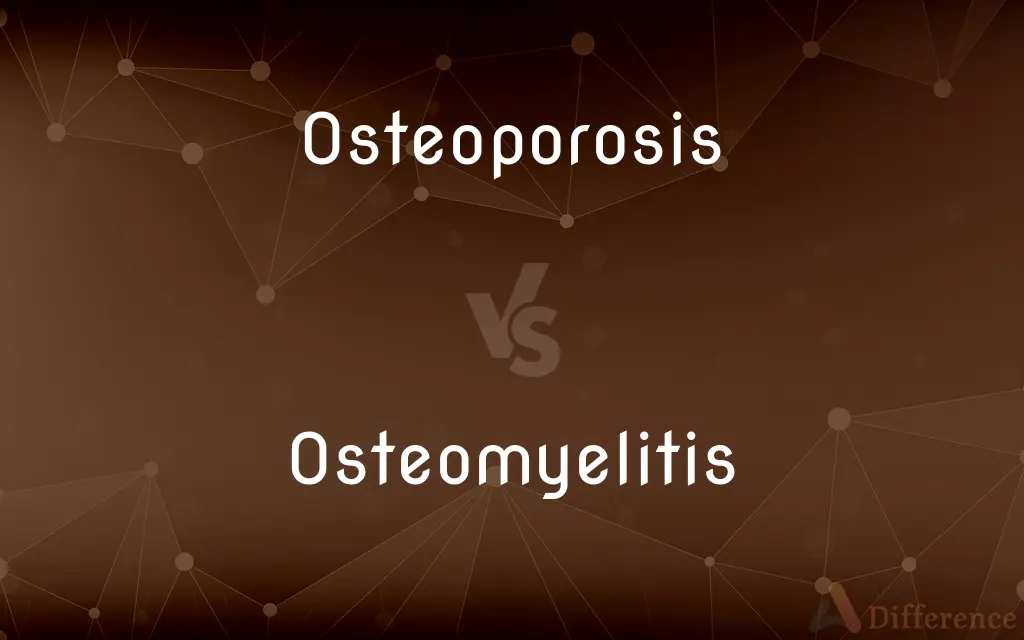Osteoporosis vs. Osteomyelitis — What's the Difference?
By Tayyaba Rehman & Fiza Rafique — Updated on April 17, 2024
Osteoporosis is a bone weakening condition due to density loss, whereas osteomyelitis is an infection in the bones caused by bacteria or fungi.

Difference Between Osteoporosis and Osteomyelitis
Table of Contents
ADVERTISEMENT
Key Differences
Osteoporosis primarily affects bone density and strength, leading to increased fragility and susceptibility to fractures. Whereas osteomyelitis is a serious condition where an infection, typically bacterial, affects the bone directly, potentially leading to severe health complications.
Osteoporosis often develops silently over years without symptoms until a bone breaks, typically in the hip, spine, or wrist. On the other hand, osteomyelitis usually presents with acute symptoms such as pain in the affected area, fever, and general malaise, which are indicative of an infection.
Risk factors for osteoporosis include aging, hormonal changes, and insufficient intake of calcium and vitamin D, highlighting its metabolic basis. In contrast, risk factors for osteomyelitis include recent injury or surgery, having a chronic open wound, or having an underlying condition that affects the immune system, emphasizing its infectious nature.
Treatment for osteoporosis generally involves lifestyle changes, dietary supplements, and medications that help build or maintain bone density. On the other hand, osteomyelitis requires aggressive treatment, often involving antibiotics or surgery to remove infected tissue, which reflects the urgency of controlling an infection.
Prevention of osteoporosis focuses on maintaining adequate bone health through diet and exercise, particularly during the bone-building years of youth. Conversely, preventing osteomyelitis involves protecting against infections, ensuring cleanliness in wounds, and sometimes using prophylactic antibiotics in high-risk situations.
ADVERTISEMENT
Comparison Chart
Definition
A bone disease leading to decreased density and strength of bone.
An infection in bone by bacteria or fungi.
Primary Cause
Metabolic changes, calcium or vitamin D deficiency.
Bacterial or fungal infection.
Symptoms
Often asymptomatic until fracture occurs.
Pain, fever, swelling at the infection site.
Key Risk Factors
Age, gender (more common in women), genetics.
Open wounds, surgery, compromised immune system.
Treatment
Medications to strengthen bone, supplements, lifestyle changes.
Antibiotics, surgery, removal of infected tissue.
Compare with Definitions
Osteoporosis
Primarily linked with aging and hormonal imbalances.
As she aged, her concern about osteoporosis grew, prompting regular bone density tests.
Osteomyelitis
An infection in the bones, usually caused by bacteria or fungi.
He developed osteomyelitis after bacteria from his wound infected his shin bone.
Osteoporosis
A medical condition characterized by the thinning of bone tissue and loss of bone density over time.
After her diagnosis with osteoporosis, she started calcium supplements to strengthen her bones.
Osteomyelitis
A condition that can cause severe pain and requires medical intervention.
The pain in his leg turned out to be osteomyelitis, requiring immediate treatment.
Osteoporosis
A systemic skeletal condition that increases the risk of fractures.
His osteoporosis made him more cautious as even a minor fall could lead to serious fractures.
Osteomyelitis
Often associated with recent injuries or surgical procedures.
Post-surgery, he was diagnosed with osteomyelitis at the site of the incision.
Osteoporosis
Characterized by porous and fragile bones.
The X-ray showed her bones were porous, a classic sign of osteoporosis.
Osteomyelitis
Treatment involves antibiotics and sometimes surgical debridement.
Her treatment for osteomyelitis included a six-week course of antibiotics.
Osteoporosis
A progressive bone disease particularly affecting postmenopausal women.
Osteoporosis is prevalent among older women, often manifesting after menopause.
Osteomyelitis
Can lead to severe complications if not treated promptly.
Untreated osteomyelitis can lead to the loss of limb or even life.
Osteoporosis
Osteoporosis is a systemic skeletal disorder characterized by low bone mass, micro-architectural deterioration of bone tissue leading to bone fragility, and consequent increase in fracture risk. It is the most common reason for a broken bone among the elderly.
Osteomyelitis
Osteomyelitis (OM) is an infection of bone. Symptoms may include pain in a specific bone with overlying redness, fever, and weakness.
Osteoporosis
A disease characterized by a decrease in bone mass and density, occurring especially in postmenopausal women, resulting in a predisposition to fractures.
Osteomyelitis
A usually bacterial infection of bone and bone marrow in which the resulting inflammation can lead to a reduction of blood supply to the bone.
Osteoporosis
(pathology) A disease, occurring especially in women following menopause, in which the bones become extremely porous and are subject to fracture.
Osteomyelitis
(pathology) An infection of the bone
Osteoporosis
An absorption of bone so that the bone tissue becomes unusually porous. It occurs especially in elderly men and postmenopausal women, and predisposes the elderly to fractures of the bones.
Osteomyelitis
An inflammation of bone and bone marrow (usually caused by bacterial infection)
Osteoporosis
Abnormal loss of bony tissue resulting in fragile porous bones attributable to a lack of calcium; most common in postmenopausal women
Common Curiosities
Can children get osteomyelitis?
Yes, children can develop osteomyelitis, often due to an infection spreading from a nearby wound or after a fracture.
How is osteomyelitis diagnosed?
Osteomyelitis is diagnosed through blood tests, imaging tests such as X-rays or MRIs, and sometimes bone biopsies.
Is osteomyelitis contagious?
Osteomyelitis itself is not contagious, but the bacteria or fungi causing it can spread from person to person.
What are common treatments for osteoporosis?
Common treatments for osteoporosis include bisphosphonates, hormone replacement therapy, and lifestyle modifications such as increased physical activity.
Can osteomyelitis lead to other health issues?
Yes, osteomyelitis can lead to complications like bone destruction, sepsis, and reduced limb mobility if not adequately treated.
What role does diet play in managing osteoporosis?
Diet is crucial in managing osteoporosis; adequate intake of calcium and vitamin D is essential for bone health.
How quickly does osteomyelitis develop?
Osteomyelitis can develop rapidly, especially in acute cases following an injury. Chronic osteomyelitis develops slowly over time.
What preventive measures can be taken against osteomyelitis?
Preventive measures include proper wound care, avoiding infections, and timely treatment of any infections to prevent their spread to bones.
What are the early signs of osteoporosis?
Early signs of osteoporosis can be subtle and go unnoticed until a bone fracture occurs; however, some may experience back pain or a gradual loss in height.
Can osteoporosis be cured?
While osteoporosis cannot be completely cured, it can be managed effectively with medications and lifestyle changes to reduce the risk of fractures.
How does physical activity impact osteoporosis?
Regular physical activity strengthens bones, increases bone density, and reduces the risk of osteoporosis-related fractures.
What are the long-term effects of osteomyelitis?
Long-term effects can include chronic pain, loss of use of the infected limb, and recurrent infections.
Share Your Discovery

Previous Comparison
Enslave vs. Subjugate
Next Comparison
Wardrobe vs. CostumeAuthor Spotlight
Written by
Tayyaba RehmanTayyaba Rehman is a distinguished writer, currently serving as a primary contributor to askdifference.com. As a researcher in semantics and etymology, Tayyaba's passion for the complexity of languages and their distinctions has found a perfect home on the platform. Tayyaba delves into the intricacies of language, distinguishing between commonly confused words and phrases, thereby providing clarity for readers worldwide.
Co-written by
Fiza RafiqueFiza Rafique is a skilled content writer at AskDifference.com, where she meticulously refines and enhances written pieces. Drawing from her vast editorial expertise, Fiza ensures clarity, accuracy, and precision in every article. Passionate about language, she continually seeks to elevate the quality of content for readers worldwide.
















































